Staff Inquiry: Nous Aimons Paris
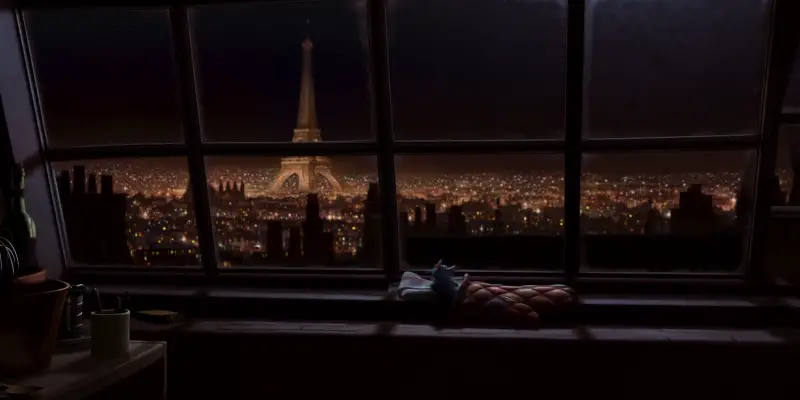
Arlin is an all-around film person in Oakland, CA. He…
It’s been a week now since the world was shocked by a string of attacks throughout the city known world over as the civic symbol of love. Paris is many different things to many different people, and whether or not one has had the occasion to even visit, it is likely that they at least hold some associations with it, something representative of its ranking it among the world’s top tier metropolises.
With Paris, as with most things, there is no better window into the place it holds in the hearts of those looking both from the outside as well as within as the frame of the movie screen. Though world events come as a whirlwind at first, slowly fading with time, the following films will be shaping perceptions of the city of lights for generations to come.
Julia Smith – Sarah’s Key (2010)
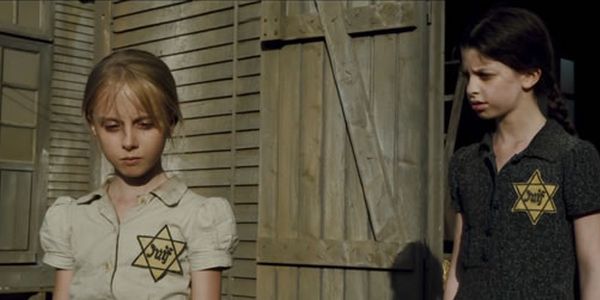
dir. Gilles Paquet-Brenner
Sarah’s Key is based on the novel by Tatiana de Rosnay. Starring Kristin Scott Thomas, the film is about a journalist in modern day Paris researching the infamous 1942 Vel’ d’hiv Roundup and the story of one of its victims, a young girl called Sarah. When it came to choosing a film set in Paris there were so many choices, there are so many films about how beautiful it is, how romantic, but Sarah’s Key will always stick in my mind above all others because it taught me something those others couldn’t.
The Vel’ d’hiv Roundup is an event it seems nobody knows about, at least outside of France. When we watch WWII films they are through British or American eyes. When Paris is referred to in these films it is always the place where soldiers go to party after D-Day, and the French themselves are always portrayed as the cool, tenacious resistance. Never do we address the true horrors of what the French went through in WWII.
The Vel’ d’hiv was the nickname for the Paris velodrome. On the 16th & 17th July 1942, under the instruction of the Nazis, the French police arrested over 13,000 Jews (a 3rd of whom were children) and held them in the crowded velodrome (and other internment camps). They would stay there for several days. They came with barely any belongings, were given next to no food, and sanitary facilities there soon became unusable. They were then shipped off to Auschwitz.
Sarah’s Key is all about a little girl who, with her family, is taken to the velodrome, but not before she has hidden her younger brother. In the present, Julia (Thomas) must solve the puzzle of Sarah and her family’s fate. It is a fictional mystery, but it is also a very real, heartbreaking story that is too often forgotten.
Sarah’s Key is an important tale and one that is about much more than the people of Paris. It is about fighting for people who can’t be heard, lost history, collective amnesia, and the ill treatment of those by the people that would believe that different is bad. In a time where innocent people are being attacked across the globe, while further victims are treated like the enemy, what could be more important than to remember the lessons of the past? We need to stick up for one another, and most importantly, we need to stick together.
Samuel James – Amélie (2001)
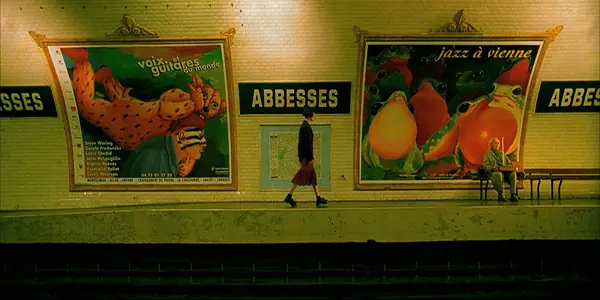
dir. Jean-Pierre Jeunet
Could there be any contemporary French film that reflected a more enchanting representation of Paris than Amélie? That is certainly a competitive question to answer but Amélie certainly proves its worth as one of the most wonderful films set in La Ville Lumiére. Written by Guillaume Laurant and directed by Jean-Pierre Jeunet, Amélie sets in stone an original story with Paris at its most dazzling from the perspective of a young, imaginative girl and her surroundings. A lot of the film’s success was actually due to its picturesque vision of the Parisian society, though criticisms were made from it. Amélie received five Academy Award nominations including Best Original Screenplay, Best Foreign Language Film and for its technical qualities in Best Cinematography, Best Sound and Best Art Direction.
In many ways, Amélie is a fairy tale set in Paris and its titular character is represented as a princess-like protagonist. As we follow her story in the Parisian streets and among her people, we progressively fall in love with her as we do the city. Amélie’s naivety blends in with the glistening portrayal of Paris and by our attraction to her, the character catapulted Audrey Tautou’s career towards international fame. That being said, the key to Amélie’s success came about not only from its characters and uniquely original concept, but also its use of location shooting and how it contributed so valuably.
Known as one of the films that used numerous exterior locations in Paris, Amélie was filmed among various sites among the city. From tourist attracted locations like Notre-Dame, La Motte-Picquet Grenelle Metro station and The Basilica of Sacré-Cœur to cafés and houses down the streets, some of which were near where the November 2015 attacks occurred. As previously stated, we follow Amélie on her journey for romance in the city by which we also explore around the sites. The film uses particular locations to explore Amélie’s fantasy-like lifestyle, especially the Café des Deux Moulins (where she works) and Rue des Trois-Frères (where she lives), and interprets the cultural routine of Parisians as something beautiful.
Criticisms were primarily from its unrealistic interpretation of what Paris is like in real-life. It may, in fact, be an archetypical vision. Despite this, people go to the city to be engrossed by what is within Paris and Amélie’s representation of the City of Light is what we, the audience, want to see.
Alex Lines – Le Cercle Rouge (1970)
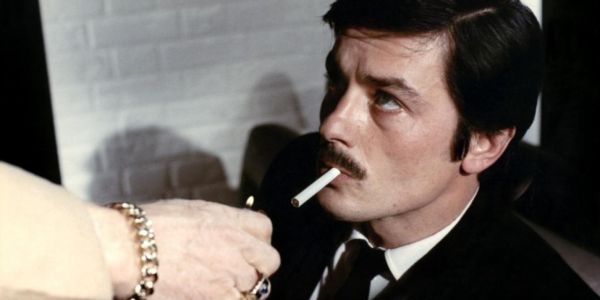
dir. Jean-Pierre Melville
French director Jean-Pierre Melville is one of the pioneer’s of ‘cool’ cinema. Between this film and Le Samourai, Melville made the gangster genre cool again. He achieved this by injecting his films with a cold atmosphere, smooth/disciplined characters and vivid color palettes, which made his films quite aesthetically pleasing. This style made these characters quite hip and not the usual stereotypical dishevelled gangsters usually seen in 1950’s-60’s American crime films.
The influence of Le Cercle Rouge can be seen throughout crime films that followed this, the most recent example being last year’s John Wick (which even featured a nightclub called The Red Circle, an English translation of the title). The film is about 3 different criminals from various paths meet and decide to perform a risky jewellery store heist. The title, The Red Circle, is based on a fictional Buddhist quote, about how no matter what path we take in life, there are certain people around us that fufill our ultimate destiny. The French landscape is given quite a modernistic look, with the cinematography really highlighting the growing contemporary landscape at the time.
The film shares some similarities with Jules Dassins’ Rififi, such as the calm/collected characters and silent bank heist scenes, with Le Cercle Rouge featuring a 25 minute long heist scene completely in silence, which encapsulates its audience by drawing them into it and by already establishing the tension by highlighting the riskiness of the operation, has us completely consumed by the penultimate scene.
Much like the other films featured this week, the stylish cinematography employed in this film, such as the use of cool (in the literal sense) colours and the controlled style that Melville uses gives the film a very professional and composed feel, lacking cheap plot elements or uncharacteristic components appearing throughout its long 140 minute running time. This film is essential Jean-Pierre Melville (other recommended titles being Le Samourai, Le Doulos and Bob the Gambler) and also essential for anyone wanting to understand one of the originators of cool, post modern cinema which evolved into the diverse pop-culture orientated cinema seen today from directors like Quentin Tarantino and Jim Jarmusch.
Alistair Ryder – Ratatouille (2007)
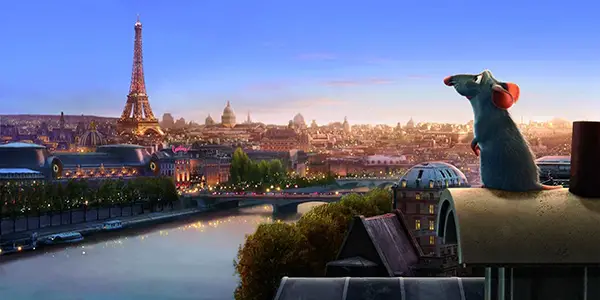
dir. Brad Bird
In my mind, Disney and Paris have always been intertwined. It is strange, considering that Walt’s studio are as all-American as apple pie- even when considering many of their most beloved early animations are family friendly adaptations of European fairy tales and folklore. When I was six years old I visited France for the first time, as my parents took me on a trip to Euro Disney; even though it is located 20 miles away from the centre of Paris, it didn’t stop me living an entire lifetime under the impression the mouse house and the French capital are directly related. Both were fantasy kingdoms- one the home to the characters of all my beloved childhood films, the other the home to some of the biggest buildings six year old me had ever seen.
Although I had long grown out of viewing Paris as nothing more than an extension of Walt Disney’s consumerist imagination by the time Pixar’s Ratatouille was released in 2007, the movie still acts as an emotional nostalgia trip. Although it is a rare Pixar movie that doesn’t provoke hysterical crying in audiences, I can’t help but find myself become emotional at Remy’s (voiced by Patton Oswalt) belief that Paris is a magical city where you can make your dreams happen; the tracking shot as he crawls through different apartment buildings, finally ending up at a window overlooking the Eiffel Tower, is nothing short of magical.
Ratatouille is a children’s movie, with the portrait of Paris painted being an idealistic one that imagines it solely as a place where dreams can come true and romance is always on the cusp of blossoming; but my inner child, who saw Paris as a strange fantasy kingdom, always refuses to let me see the negative side of the city. Ratatouille pays tribute to the city in such an elegant fashion, despite its clear idealism- as the city lies in mourning, we should give in to the romanticism presented by director Brad Bird and remember Paris in this way.
Arlin Golden – La Haine (1995)
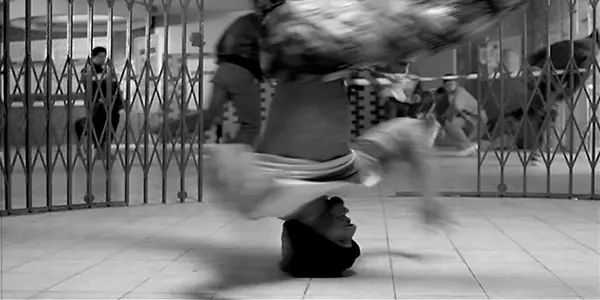
dir. Mathieu Kassovitz
Along with Amélie, this is the film that was probably unavoidable for inclusion in this article. Depicting a day in the life of three Parisian sons of immigrants who live in the same housing project, La Haine (Hate) deals with issues still existing on the surface a full 20 years after its release. Lacking a traditional plot, the film follows Vinz, a Jew, Said, a Muslim, and Hubert, an African-French, as they navigate their home in the projects and the city at large in the wake of a riot in which one of their friends was put in a coma by police. The trio meander about seeking to occupy their idle time, visiting various Parisians of all races and classes, finding both fun and tragedy lining the streets.
The film opens with a voice over of Hubert recounting a joke about a falling man who on his descent repeats to himself “so far so good…”, making an analogy with the race divide in Paris and its suburbs; it can’t end well. It is tempting to see last week’s tragedy as the falling man having finally reached Earth, as Paris’ inability to address systemic and casual racism has led to a predictable and devastating conclusion. But we know better than to go victim-blaming, and while I am certainly not the one to state a cause for the attacks, I think it is clear that they were the result of a level of religious fundamentalism that had yet to even be conceived of in ’95, and not societal unrest as addressed in the film. That being said, La Haine and its characters are more relevant today than ever before.
The film was shot entirely on color stock, with was then converted to black and white in post with brilliant results. The black and white world of La Haine is thus not that of stark contrasts which we recognize from the days of noir, but rather a subtler sea of grays and gradations that are a more honest reflection of the nuances and idiosyncracies of life of second-generation immigrants in the city. Thus does the cinematography itself help to strip away the romanticized vision the world has of Paris for one I imagine its citizens more readily recognize; vibrant, chaotic and human.
Mike Daringer – Charade (1963)
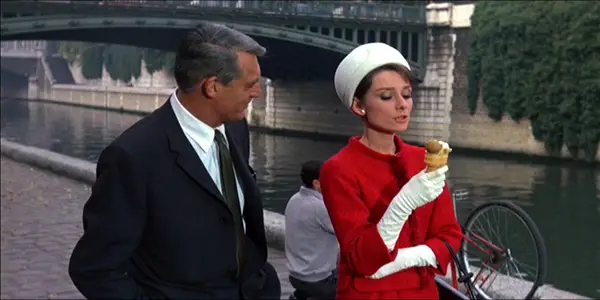
dir. Stanley Donen
Charade is the first film that comes to my mind when I think about Paris. It’s one of a handful of movies that cemented my love of cinema, and gave the thrills and escapist glee that life seldom creates, unless in Paris. It’s a fun, lighthearted fare but it’s still wonderfully crafted and boasts two of the silver screen’s biggest stars.
Cary Grant and Audrey Hepburn run around Paris in Stanley Donen‘s screwball comedy and they try to find $250,000. Hepburn becomes suspect of having plotted the murder of her husband and Grant gets involved with unclear motives, changing his identity just as much as he does his wardrobe. There’s barely any final act and sequence as memorable as when Hepburn meets Walter Matthau at the Colonnade in the Jardin du Palais Royal, and the ensuing foot-chase climaxes at the state theater of France, the Comédie-Française. It’s a fun movie that doesn’t sacrifice style and execution for entertainment’s sake.
But what really sticks out about Charade is Paris. When somebody says something along the lines of, “It’s as if the city is a character in the movie,” this is that movie and that city that people are talking about. Sure, Donen capitalized on some of the big touristy sites and landmarks, like Notre Dame, but he still managed to make the city of love just that — one big, romantic ode to meaningful relationships. Charade captures the city’s notoriety of having a lavish nightlife, and more than that boasts that Paris is a human accomplishment that won’t, and instinctively can’t, bow to hatred.
Jax Griffin – Breathless (1960)
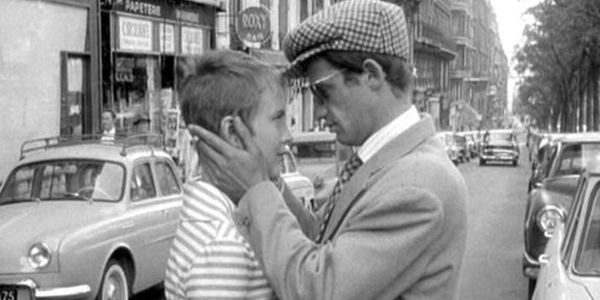
dir. Jean-Luc Godard
If you’ll forgive it, I’m not going to talk about the film so much, but rather how it portrays Paris. In the light of all that has happened in the past week, I still love the city. And it’s this love of the city of Paris, that desire for expressing it, that led me to choose to talk about Breathless by Jean-Luc Godard. The city of Paris becomes a character in the film as we get to know certain locations and associate them with either Belmondo’s character or Jean Seberg’s. When I first went to Paris, I found myself on the street, half expecting to see a short-haired American girl selling newspapers.
I discovered that the city is in fact as winding and strange as it seemed to me upon watching Breathless for the first time. I discovered that the city moved with you, and breathed with you, much as it seems to in Godard’s film, perhaps due to his innovatory and much lauded editing style. And most of all, I discovered that it is a city that continues, a city with a current that you get swept up in. For Belmondo in Breathless, he drowns, but for me, it carried me. I don’t think Godard was portraying Paris positively or negatively. I think Paris simply exists and becomes intertwined in his characters’ lives, as it has now in all of our lives.
Dave Fontana – Midnight In Paris (2011)

dir. Woody Allen
When asked to think of the movie that most reminded me of Paris, the first film that came to mind was Midnight in Paris. With all of its famous landmarks and iconic café-lined streets, the city has always been known as a romantic and gorgeous place to visit. But through Woody Allen’s eyes, it manages to become something even more than that.
Much like some earlier Allen films (The Purple Rose of Cairo, for example) Midnight in Paris is an example of magical realism that works because it doesn’t focus on the specifics of it. The story concerns a man named Gil (played by Owen Wilson), an American writer visiting Paris with his fiancé. After getting too drunk one night, he hitches a ride with some party-goers and somehow ends up getting transported back to Paris in the 1920’s. Along the way, he meets up with F. Scott and Zelda Fitzgerald, Ernest Hemingway, Pablo Picasso, Gertrude Stein, and others.
In the film, Paris itself is an absolute delight. By not only presenting the city in the present but also in two different time periods of the past (the 1920’s and La Belle Époque of the 1890’s), we are able to see just how transcendent the place truly is, and how for this reason Paris attracts some of the most celebrated artists of their respective times. From bars crowded with sharply-dressed people to extravagant parties with only the most lively musical accompaniment – at one point, Gil speaks of the city as “the hottest spot in the universe.” As vibrantly and beautifully presented as it is by Woody Allen, it’s not hard to imagine it as so.
What’s your favorite piece of Parisian cinema?
Does content like this matter to you?
Become a Member and support film journalism. Unlock access to all of Film Inquiry`s great articles. Join a community of like-minded readers who are passionate about cinema - get access to our private members Network, give back to independent filmmakers, and more.
Arlin is an all-around film person in Oakland, CA. He received his BA in Film Studies in 2010, is a documentary distributor and filmmaker, and runs Drunken Film Fest Oakland. He rarely dreams, but the most frequent ones are the ones where it's finals and he hasn't been to class all semester. He hopes one day that the world recognizes the many values of the siesta system.













